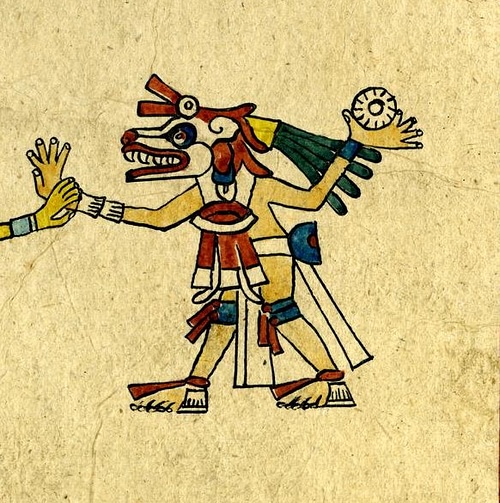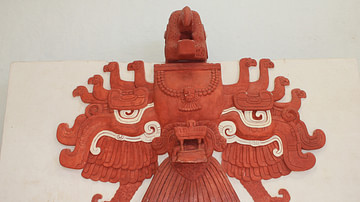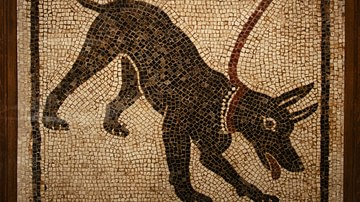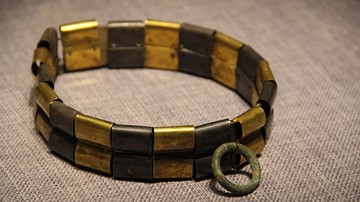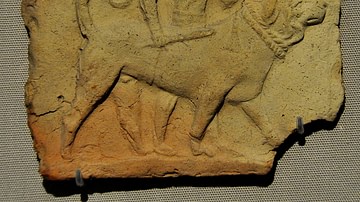Dogs were an integral aspect of the lives of the people of Mesoamerica regardless of their location or culture and, throughout the region, were recognized as liminal beings belonging not only to the natural world and that of humans but to this world and the next.
Dogs were believed by the Aztec, Maya, and Tarascan to travel between worlds, assist the souls of the dead, warn of dangers to the living and, at the same time, were regarded as a food source, companion, and guardian in daily life. The dogs of the indigenous people are frequently depicted without collars because it seems to have been thought that these would restrict the dog’s movement between worlds.
Even so, collars did exist – fashioned for humans to wear – and it is thought that these developed from dog collars. This model changed with the arrival of Christopher Columbus (l. 1451-1506) in the West Indies in 1492. Columbus’ dogs all wore collars and were much larger than the animals the natives were used to. The European dogs had also been trained for war and so were far more savage than any dog a Taino, for example, had ever known.
After Columbus, who sailed for Spain, more Spanish invaders arrived and made their way north through South America to Mesoamerica, bringing Christianity with them. Christianity began to replace indigenous beliefs and, as the Catholic Church claimed dogs had no souls, belief in the supernatural power of the dog declined. Although there were no doubt many indigenous peoples who still believed in the dog as a psychopomp, there is no widespread evidence of this belief after the arrival of the Spanish as compared with pre-Columbian Mesoamerica. The descendants of the ancient people of the region have only begun restoring their ancient cultures in the past 100 years and so, in time, the dog has slowly regained the status it once held.
Olmecs & Their Dogs
The Olmecs of Mesoamerica lived in the lowlands along the Gulf of Mexico c. 1400-400 BCE and bred dogs as food. The Olmecs are the oldest civilization in the western hemisphere, inventing the first written language of Mesoamerica as well as distinctive art and architecture which would influence the later civilizations of the Aztecs, Maya, and Tarascan, among others. The sacred animal of the Olmecs was the jaguar which was thought to be spiritually related to the dog. The dog was therefore associated with the divine while, at the same time, serving as a food source. There seems to have been no contradiction in this as dogs, servants and messengers of the gods, also served humanity by graciously offering themselves as food.
A tomb of the Zoque peoples, a Mesoamerican population thought to be descended from the Olmec, was discovered in 2010 in Chiapa de Corzo containing jade collars. These were ornamental collars for human wear but could have developed from the dog collar. The tomb dates to between 700-500 BCE and is the oldest pyramid tomb yet found in the region.
The indigenous people of modern-day Mexico, Belize, Guatemala, Honduras and neighboring regions, built pyramids as temples, not as tombs, and this find is thought to reflect an earlier Olmec practice of keeping precious objects in temples – one that was observed by later cultures. The jade collars, though clearly for human use, could have linked an officiant with the spirit of a liminal dog who would bring messages from the gods.
Dogs in Maya Religion
The Olmecs gave way to other civilizations and were replaced primarily by the Maya who continued the practice of breeding dogs in pens and using them for food. Dogs also featured prominently in Maya mythology, however, and were treated quite well in daily life. In the beliefs of the Yucatec Maya, dogs served to guide the souls of the dead through the dark underworld of Xibalba toward paradise and, in the myths of the Quiche Maya, dogs serve the will of the gods in destroying the ungrateful and useless race of humans first created before the present race.
These earlier humans had been made of wood by the gods but forgot their duty to their creators and to their fellow creations. The gods delivered these ungrateful and cruel creatures up for punishment by the animals – and even the inanimate objects – they had abused. When they are handed over to the dogs, the animals say to the humans:
Why is it you can’t seem to give us our food? We just watch and you just keep us down and you throw us around. You keep a stick ready when you eat, just so you can hit us. We don’t talk, so we’ve received nothing from you. How could you not have known? You did know that we were wasting away there behind you. So this very day you will taste the teeth in our mouths. We shall eat you. (Tedlock, 72)
The dogs then fall upon the humans and destroy them. Dogs are the only creatures among the many elements of life on earth chosen by the gods to destroy these inferior beings so that new life can be created from maize (corn). Inanimate objects such as tortilla griddles, cooking pots, hearth stones, and grinders, all of which have been abused and misused by the ungrateful and uncaring people, also join in attacking them. Once they are destroyed, the new people are then made of corn, a staple of the Maya diet, and these creatures learn grace and gratitude and the proper attitude toward the gods. The Maya fed corn regularly to their dogs as the basic sustenance of life and, perhaps, to encourage their own obedience to the higher powers which provided that corn.
The dog features later in the Popol Vuh, the religious book of the Quiche Maya, in the tale of how the hero twins Hunahpu and Xbalanque trick the dark lords of the underworld of Xibalba. The twins have been taken by the Xibalbans and, in trying to win their freedom, are repeatedly tested by the lords, who are notorious for tricking the souls of the dead and leading them astray. The twins have passed each test when they tell the lords that they have the power over life and death. To prove this, they sacrifice a dog belonging to the lords and then bring it back to life.

The Lords of Xibalba are so impressed they want to be sacrificed and returned to life also and so they offer themselves to the twins. Hunahpu and Xbalanque kill each one in turn but never had any intention of resurrecting them. Afterwards, they are free to leave the dark realm and return to the surface world. The story elevates the dog from a simple food source, worker, and guardian to the supernatural level of psychopomp since it has seen death, returned to life, and so can guide humans when their time comes to make the same journey.
Dogs as Symbols of Transformation
The dog as a guide to the afterlife is famously depicted in a painting from Temple I at Tikal in Guatemala. The painting shows the twin Paddler Gods - Old Stingray Paddler and Old Jaguar Paddler - conveying the Maize God to the underworld. In the boat with them are an iguana, a spider monkey, a parrot, and a dog. The Paddler Gods helped build the Cosmic Hearth for the other deities at the beginning of creation and symbolized the dance of opposites which kept the universe in balance. They are frequently seen in Maya artwork taking the Maize God away toward the land of the dead or bringing him back to life on earth. In this tomb painting from Tikal, directly behind Old Jaguar Paddler in the front of the boat, is the dog acting as guide.
The Classic Maya Period runs from 250-950 CE during which time their civilization was at its height. Children's toys from this time include dog figurines with collars. Dogs are also depicted in statuary with collars which appear to have been a band of leather or cloth of varying widths. Dogs were also used for hunting, protection, and companionship and, although they no doubt wore collars, none of these have survived. Based upon images from pottery and wall paintings, the collars were brightly colored in red, black, and turquoise and this was true for other civilizations of the region.
Dogs of the Aztec & Tarascan
The Aztecs and the Tarascan civilization were traditional enemies but both kept dogs for the same reasons and regarded them in much the same way. In Aztec belief, dogs were associated with Xolotl, the god of lightning, sunset, and death, who was imagined as an enormous dog. Xolotl was thought to be the creator of the breed known today as the Xoloitzcuintli also known as the Mexican Hairless, the Xolo, and the Dog of Xolotl. Xolotl is regularly depicted wearing a thick collar, usually of red, and created the dog to protect the living and guide the souls of the dead through Mictlan, the Aztec underworld, similar to the Maya Xibalba as a place of darkness and danger.
The Xolo was already ancient at the time of Columbus' arrival in the New World and dates back at least 3,500 years. They were primarily bred for food but sometimes, if a particular dog seemed to possess healing powers, it was spared and perhaps this was when it would receive a collar. The Aztec and Tarascan, like the Maya, believed that dogs were servants of the gods and especially effective at guiding, comforting, and appeasing the souls of the dead.
Improper burial was as serious a matter in Mesoamerica as anywhere else in the ancient world and the ghost of someone who had not received the proper rites was sure to return to haunt the living. Dogs were thought to be expert in locating the souls of those who had died but could not pass on without proper burial (people who drowned, for example, or were killed while hunting alone). These souls would wander the earth until they were found by a spirit dog which would lead them to the afterlife and allow them their rest.
Dogs in Aztec Art
Dog images were included in the graves of those buried with all proper rites and rituals, however, and were by no means only invoked for the souls of those lost or missing. The famous Colima dog ceramics (vessels in the shape of dogs or dog figurines, so-called because they have been found largely in the state of Colima, western Mexico) have been discovered in over 75% of the burials of the Pre-classic Period (c. 300 BCE-300 CE). These dog figures are often rounded, suggesting fat and plentitude, and the spirits of these robust dogs would have nourished the soul of a deceased human as it traveled through Mictlan toward paradise.
Dog collars are not shown on the dogs in most Mesoamerican art, however, because these images usually depict the dog-as-symbol. The famous Colima Dancing Dogs, for example, are probably symbolic representations of life and death, of the balance of opposites in union, not a realistic depiction of dogs. The Colima Dog statuettes and other figurines which show a fattened dog with an ear of corn in its mouth most likely served the same symbolic purpose.
Dogs were fed on corn and a fat dog suggested health and a good harvest and so these statues probably symbolized "plenty" or "abundance". As noted, dog figures were frequently buried with the dead to help guide the soul, as were actual dogs, since it was believed the soul would need sustenance for its long journey through the underworld to the World Tree and the realm of paradise.
Dogs as Liminal Beings
It is possible that dogs are not seen with collars because of their status as protectors and guides. The Mesoamerican belief in tonalism and the concept of the Nagual might have something to do with this as well. A tonal is a spiritual link between a person and a certain animal, established at the individual’s birth, whereby the person exhibits the characteristics and shares empathically in the life of the spirit animal. A person born linked to a dog, for example, would show canine characteristics but the link is so strong that, if the spirit animal is in some way injured, the human counterpart would feel the effects. The nagual is a religious practitioner – a shaman – who has the power to shape shift and can become whatever animal he or she chooses, usually at night.
The tonal and nagual are intertwined in that the nagual must be able to “read” the energy of a day and understand what magic will or will not work on a certain day. The tonal is intimately tied to the energy of a day and, in Maya belief, is associated with the Wayobs (also known as the Ways), the spiritual embodiment of a day’s energy which watches over people and advises them or predicts their fortunes in dreams. A nagual, correctly reading the energy of the day, could make the tonal link with a dog and would be able to understand the messages that dog brought back from the Other World.
Since the dog was considered a liminal entity by the Mesoamerican peoples, able to transition between worlds, it could be that collars were only given to dogs under certain circumstances. A significant amount of Mesoamerican scripture and literature was destroyed by the Spanish Conquest of the 16th century CE and so it is impossible to know what these circumstances may have been. Until very recently, all archaeologists had to go on to interpret the culture were a few books – a tiny percentage of what was once a civilization’s cultural library – and artistic renderings on temple walls, stelae, and tombs. As archaeologists and other scholars have come to better understand various Mesoamerican scripts, however, the indigenous cultures are coming into sharper focus. Even so, it may never be known why or under what circumstances a dog received a collar in these indigenous communities.
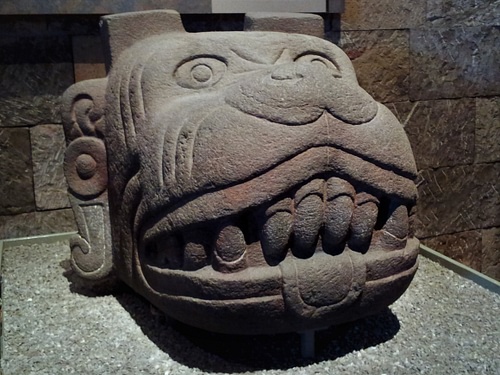
Conclusion
Dogs would also play an important role in the conquest of the so-called New World as Christopher Columbus employed dogs regularly in crushing the will of the indigenous peoples. The mastiff had been successfully used by the Spanish in the wars against the Moors of Granada and so were included in Columbus' second voyage in 1493. The same handlers who had served in Granada were sent along with the dogs and Columbus would use both to full effect. When he arrived in Jamaica in 1494, he met stiff resistance from defenders on the beach until he released the savage mastiffs which terrorized the indigenous warriors and scattered them.
Columbus would later write that one dog was worth 50 men in combat. The original 20 dogs he brought with him from Europe would grow in number as more Europeans came to the New World and these were put to the same uses they had known back in the Old World. Dogs, in fact, were found to be more effective in the conquest of Mesoamerica than most of the weapons their human handlers deployed as they completely terrorized the indigenous people.
The European use of the dog, coupled with Christianity’s insistence on dogs as soulless beings, led to the dogs’ loss of status in the region during and after the Spanish Conquest. Over the last 100 years, however, indigenous beliefs have been making a comeback and the dog is steadily regarded more in keeping with its earlier than its post-Columbian status. The so-called “Mayan Revival” of the 1920’s and 1930’s encouraged progressives in the United States and elsewhere to distance themselves from traditional European values by embracing those of Mesoamerica and the ancient status of the dog, among other aspects of the region’s indigenous culture, is better appreciated now than it was for 400 years following the Spanish Conquest.


